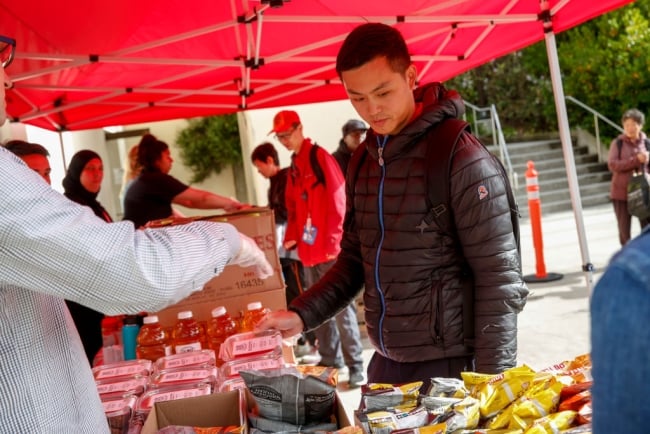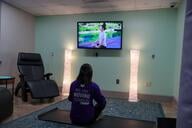You have /5 articles left.
Sign up for a free account or log in.

A student eyes his options at a food pantry offered by City College of San Francisco and the SF Marin Food Bank.
Josie Norris/San Francisco Chronicle/Getty Image
Many California community college students and University of California students are eligible for CalFresh, the state’s food assistance program for low-income Californians, but most eligible students aren’t enrolled in the program, according to a new report from the California Policy Lab, a nonpartisan research group affiliated with the University of California, Berkeley and UCLA.
The report, released Tuesday, compared enrollment and financial aid application data to the CalFresh eligibility rules to approximate how many students could be benefiting from the program. The California Community College Chancellor’s Office, University of California Office of the President, California Student Aid Commission and California Department of Social Services all contributed data to the effort.
Jesse Rothstein, co-author of the report and the Carmel P. Friesen Professor of Public Policy and Economics at UC Berkeley, said this is the first time these data sources have been studied together, so researchers didn’t know what to expect. He was surprised by how many students could be benefitting from CalFresh but weren’t.
“Students don’t know about the program,” Rothstein said. “They don’t understand that it’s available for college students. And it’s a complicated process to apply, to even know whether you’d be eligible. And so I think there’s a lot of missing information.” said Rothstein, who is also the faculty director of the California Policy Lab’s UC Berkeley site.
The report estimated that in fall 2019, 256,000 California community college students, or 16 percent of the total enrolled at system institutions, were eligible for the food benefits program. Meanwhile, 31 percent of UC system undergraduates, or a total of 69,000 students, were likely eligible, as were 6 percent of, or 3,000, UC graduate students.
But most of these students didn’t receive the food benefits for which they were eligible, the report found. Only 30 percent of eligible community college students, 22 percent of eligible UC undergraduates and 29 percent of eligible UC graduate students were enrolled in CalFresh.
“Students shouldn’t have to worry about whether or not they can afford their next meal,” Genie Kim, director of student mental health and well-being at the UC Office of the President, said in a press release. “These estimates show that we have a lot of work to do in order to improve access and connect more eligible students to CalFresh benefits.”
The report details how complex it can be for students to meet the eligibility criteria for CalFresh, the state’s version of the federal Supplemental Nutrition Assistance Program (SNAP), also referred to as food stamps. Students must not only satisfy an income requirement to be eligible for SNAP, they also must meet at least one of a list of exemptions or criteria, including parenting a young child, working at least 20 hours per week or receiving support from the Temporary Assistance for Needy Families program, or TANF. Then students must go through the onerous process of actually applying, including having their eligibility assessed by a program caseworker.
The gap between eligibility for and access to SNAP is a broader problem extending beyond California. A national student survey conducted by the Hope Center for College, Community, and Justice at Temple University in 2020 found that only 18 percent of students who reported experiencing food or housing insecurity were enrolled in SNAP. Meanwhile, a little over a quarter of students facing these struggles hadn’t even heard of the program. And 55 percent of students with basic needs insecurity reported they knew about SNAP but hadn’t used the benefit.
Bryce McKibben, senior director of policy and advocacy at the Hope Center, said there are dozens of criteria students could fall under that would make them eligible for SNAP, but navigating a “web” of federal rules to find out can be “demoralizing.”
“It’s very easy to understand why, unfortunately, students in higher ed can often just feel shut out of the program entirely,” he said. “The message that it sends is often this program is not for you.”
Gaps in Eligibility and Access
Some students were more likely to qualify for CalFresh, and access its benefits, than others, according to the report. Unsurprisingly, students receiving federal and state financial aid were more likely to be eligible and enroll in the program than those who didn’t receive aid. Black students in both the community college and UC systems were more likely than their peers to qualify, and if eligible, participate in the program. The same was true for Latino or Hispanic students at the UCs, but not at community colleges.
The report also found that community college students tend to have more difficulty qualifying for CalFresh than UC students, even though they’re more likely to come from low-income backgrounds. Because more community college students live at home with their parents whose incomes are factored into the eligibility for CalFresh, it can prevent them from meeting the program’s income requirements.
“Lots of programs are based on family income. The SNAP program is different in that it’s based on the income of the people you prepare food with,” Rothstein said. “That makes it a lot more likely that a student who's living on their own will be eligible for benefits.”
UC students also receive a version of the Cal Grant, state financial aid, funded by the federal welfare program, Temporary Assistance for Needy Families, which allows recipients to meet one of the CalFresh eligibility criteria. Cal Grants to community college students, however, are not TANF-funded.
Notably, the share of community college students eligible for CalFresh enrolling in the program, has declined from 35 percent in the 2012 to below 30 percent in 2018, while the rate of eligible UC undergraduates enrolling in the program has grown markedly from 5 percent in 2012 to roughly the same rate as community colleges after a sharp rise starting in 2017.
“This research makes it clear that many more low-income Californians could benefit from CalFresh while they’re enrolled at California Community Colleges,” Valerie Lundy-Wagner, vice chancellor of digital innovation and infrastructure at the California Community Colleges Chancellor’s Office, said in the release. But “this research partnership is building and accelerating the evidence-base for strategies to make that happen.”
Rothstein added that the growth of eligible UC students taking advantage of CalFresh is a hopeful sign that outreach efforts to students can work. He noted that UC campuses started to invest in on-campus basic needs centers around the time of the uptick.
The report also outlined attempts higher ed institutions and federal and state lawmakers have made to help students access these benefits. Notably, during the pandemic, two new exemptions were added at the federal level for students whose families don’t contribute money toward their education and students eligible for federal or state work study, but those protections phased out in spring 2023 when the federal state of emergency ended. Multiple pieces of California legislation have also taken aim at the issue in recent years, including laws requiring public higher ed institutions to share information about CalFresh at orientations and provide written notice to likely eligible students and funding basic needs centers at community colleges as hubs for students to find food and housing resources.
McKibben noted that the Hope Center recently released a report looking at how different states implement certain public benefit programs, including SNAP. It found few states had done as much as California to maximize student eligibility for food benefits.
He said the numbers in the report might seem “depressing” but “in many ways, California is the high watermark of this across the country. This is in so many ways as best as we can hope for in the context of a program that is designed to exclude students.”
“We have more to do, and California can do more,” he added. “But at the same time, the whole system honestly is just not meeting the needs of students, so we have more to do nationally.”
California Policy Lab researchers plan to continue tracking and refining the data to see how policy changes affect the extent to which students access the food benefits they need.
Rothstein said one future goal is to use the data to better understand what kinds of outreach efforts actually get students to enroll in the program.
“My hope is that we can use this information to help design more personalized outreach,” he said. “… That could go a long way towards helping increase take-up and helping more students get through college.”





